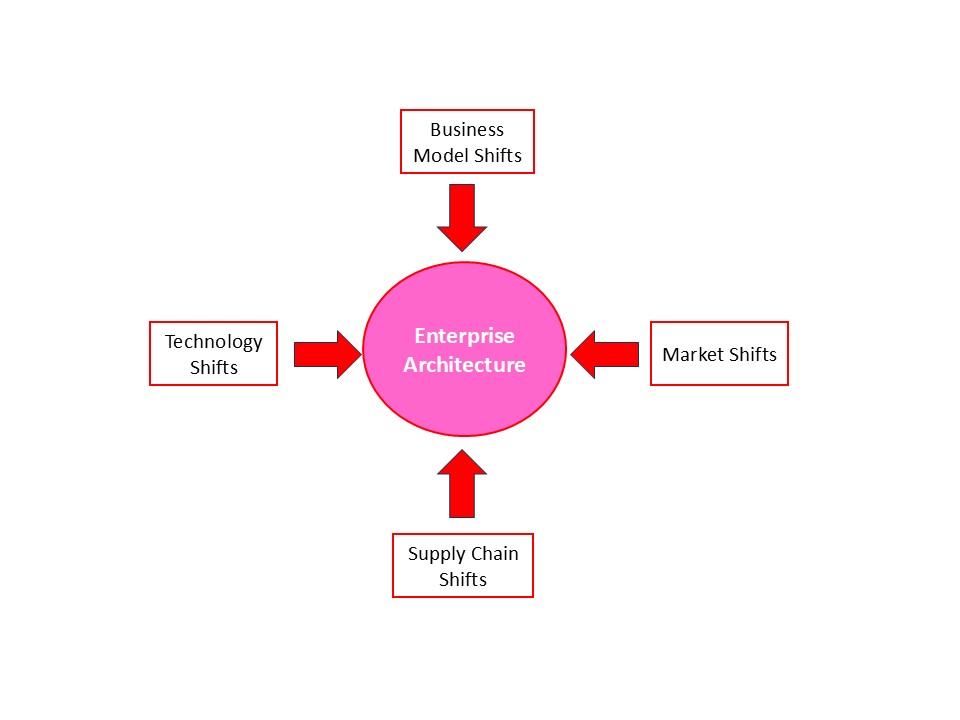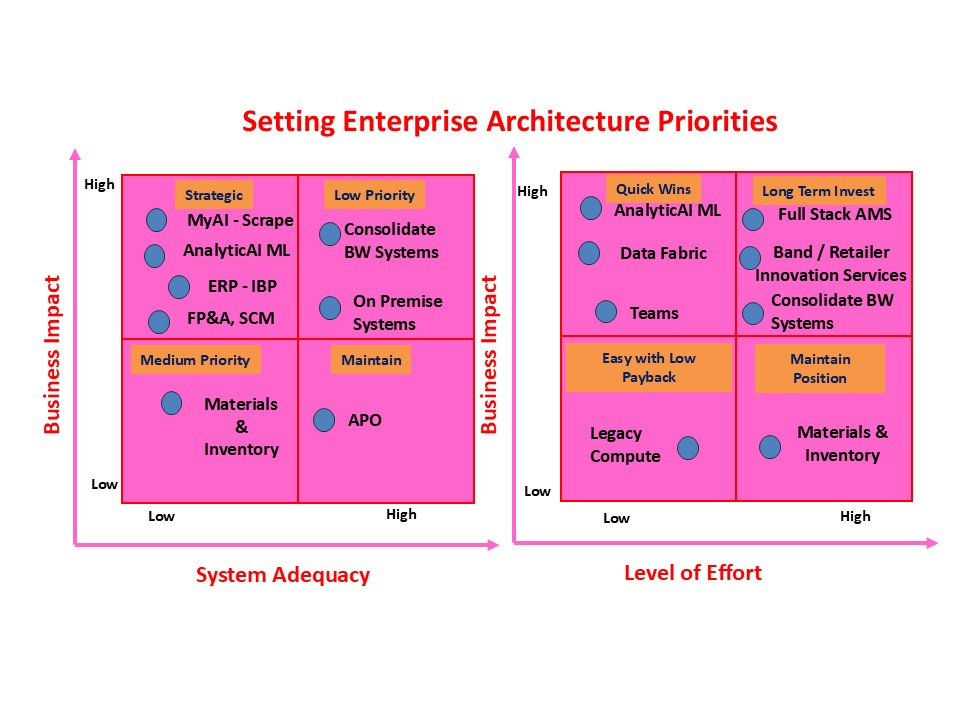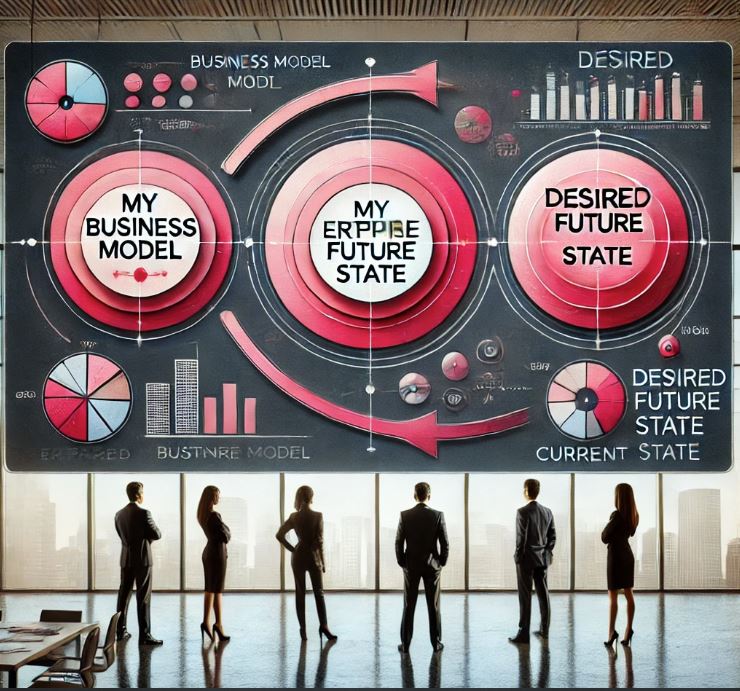Strategic Enterprise Architecture Planning
"Actively thinking about where your organization desires to be is a first step in creating a modernized enterprise architecture"
Business leadership is challenged to implement an enterprise strategic architecture with planned activities, budget and program schedules while continuously course correcting the current target strategy due to a myriad of strategic change drivers. That is, as the enerprise architecture plan is being implemented, the business model is changing or requires change. Change drivers such as poor revenue growth and high conversion costs, new technology disruption like AI LLMs, customer CRM demands, and M&A activity significantly impact the enterprise architecture plan. It takes an average organization several months of planning, analysis, scenario development, workflow and approvals to finalize an enterprise architecture strategy and budget. Once implemented, the programs within the plan are usually realized in 1, 2 or 3 year horizons with 80% budgetary focus on the current year. American company's generally lack a long term strategy, much different than Asian companies with their 20 year or more planning horizons.
Why is Enterprise Architecture strategy becoming more important?
And when is your enterprise architcture restricting your organization to achieve their goals instead of enabling business development? A good example is when ChatGTP was introduced in 2022. Most of the world was caught offguard with how disruptive the new technology is. Another is electric vehicles and their transformative impact on the auto industry. A third is enterprise ERP solutions rapidly increasing their predictive and prescriptive optimizations of business processes, analytics and forecasting using advanced AI algorithms. Organizations must adopt new ERP capabilities and functionality or face the consequences in the markeplace.
Most organizations' business model execution capabilities, whose future target state is largely defined by the capabilities of their enterprise architecture, will become restrictive if not detrimental to business strategy and operations as innovation occurs. As technology disruption strikes, inside and outside the organization, competitors and innovators will adopt and industry incumbents will not survive is they don't.
TekMetrix LLC empowers executive leaders to establish a dynamic, forward-looking management framework that continuously integrates cutting-edge technology to enhance and sustain their business models. With our software, TekMetrix AnalyticAI, we bring a visionary approach to technology planning and enterprise architecture, fostering an adaptable and open structure. This flexible architecture enables seamless adoption of new technologies and strengthens management of key enterprise assets—innovation, institutional knowledge, learning curve advancements, platform evolution, talent, and processes.
By committing to proactive technology scanning, skillful adoption, and strategic learning, organizations can thrive amid change, embedding innovative technologies as they evolve. Achieving agility requires cultivating ambidextrous thinking—where forecasting and deploying new IT capabilities are balanced with optimizing existing operations to drive cost efficiency and revenue growth. TekMetrix LLC helps organizations build this essential capability, positioning them to excel in a rapidly evolving marketplace.
What is the impact of business and IT health on enterprise architecture strategy?
| Enterprise Architecture Health Criteria | Business Health (Functional Criteria) | Technical Health (Technical Criteria) |
| Purpose | Evaluates how well each application fulfills its intended business role and meets key business metrics. | Assesses the underlying architecture and robustness of the technology to ensure efficiency, adaptability, and future-readiness. |
| Maintenance & Upgradability | Ease of implementing updates, patches, and aligning with evolving business needs. | Ability to maintain technical components efficiently, keeping systems updated and minimizing technical debt. |
| Customization & Flexibility | Degree of customization and impact on application flexibility and ability to adapt to business demands. | Capability of the technology stack to support modifications without degrading system performance or scalability. |
| Data Quality | Ensures data accuracy, consistency, and relevance for decision-making. | Verifies data structure integrity and alignment with modern standards, enabling smooth data flow and integration. |
| User Adoption & Usage Frequency | Rate of user adoption and engagement across business areas, indicating practical functionality. | Measures system performance in handling frequent user interactions, including response times under different load conditions. |
| Process Implementation & Responsiveness | Resources required for implementing new processes to meet changing business needs. | Speed and ease with which new technical capabilities and integrations can be added to support business changes. |
| Ecosystem Integration | Opportunities to enhance collaboration by integrating customers and partners into business processes. | Ability to integrate with external systems and data sources, enhancing overall system flexibility and ecosystem connectivity. |
| Total Cost of Ownership (TCO) | Encompasses all business costs of the application, including initial and ongoing expenses for maintenance and upgrades. | Includes costs associated with infrastructure requirements, cloud readiness, security, and compliance to maintain technology stack. |
| System Performance & Reliability | Measures uptime, response times, and system reliability, ensuring stable support for business processes under variable loads. | |
| Scalability | Capability of the technology to handle increasing data volumes and user demands without impacting performance. | |
| Security & Compliance | Ensures data protection, robust access controls, and compliance with industry regulations. | |
| Technology Stack Compatibility | Alignment with modern standards to ensure interoperability, ease of updates, and compatibility with future requirements. | |
| Cloud Readiness | Evaluates suitability for cloud deployment, supporting cost efficiency, flexibility, and scalability of IT resources. | |
| Automation & Monitoring | Availability of tools for automated monitoring, issue detection, and resolution to reduce downtime and enhance stability. | |
| AI & ML Capabilities | Ability to leverage AI and ML to generate insights, predict outcomes, and support real-time business decision-making. | Incorporation of AI/ML technologies to improve system efficiency, automate processes, and enable predictive maintenance and analytics. |
Enterprise architecture is the strategic integration of business goals, organizational structure, processes, computing platforms, analytics, applications, and infrastructure. It aligns an organization’s vision with IT capabilities, allowing technology to drive business outcomes. For large enterprises, this may mean harmonizing multiple SAP instances and thousands of applications, while for small-to-medium enterprises, a single ERP system might be a central IT strategy. Regardless of size, an effective enterprise architecture defines both the current state and the future vision, creating a roadmap to close the gap between current state and desired future state remaining competitive.
To realize this architecture, organizations must commit to a clear plan that gains organizational buy-in before technology solutions are deployed.
Key Benefits of TekMetrix LLC's Ambidextrous Approach to Enterprise Architecture:
- Enhanced Asset Productivity and Effectiveness: Track and optimize asset use to maximize ROI.
- Strategic Business Model Innovation: Embrace planned changes that keep the business agile and relevant.
- Alignment Between IT and Business: Achieve synergy, where IT empowers business goals and business strategy guides IT.
- Quick Wins: Deliver fast, impactful improvements that build momentum.
- Agile Adoption of New Models: Transition smoothly to new business models and processes.
- Efficiency Gains: Achieve more with fewer resources by optimizing and scaling intelligently
Developing an Enterprise Architecture
Start by conducting a thorough, objective assessment of your current business ecosystem with TekMetrix tools, methods and frameworks. Evaluate each application’s health by balancing functional and technical criteria, in collaboration with business subject matter experts.
Functional Health
Functional health measures how well an application fulfills its intended role, such as meeting key metrics for supply chain, order-to-cash, record-to-report, and maintenance predictions. Assess whether the application can deliver current and future functionality effectively. We consider such specifics as:
- Maintenance and Upgradability: Ease of system updates, patching, and alignment with evolving business needs.
- Degree of Customization: Level of customization and its impact on flexibility and scalability.
- Quality of Master and Transaction Data: Data accuracy, consistency, and relevance for decision-making.
- User Adoption and Frequency of Use: Rate of user adoption across functional areas and frequency of use.
- Implementation of New Processes: Resources required for implementing new processes and responding to changing business needs.
- Ecosystem Integration: Opportunities to bring customers and partners into the ecosystem for enhanced collaboration.
- Total Cost of Ownership: All costs associated with the application, including implementation, maintenance, and upgrades.
Technical Health
Technical health evaluates the underlying architecture and technology robustness to ensure it supports the business efficiently and can adapt to future demands. Key technical criteria include:
- System Performance and Reliability: Measures of system uptime, response time, and reliability under varying loads.
- Scalability: Ability of the application to scale with growing data volumes and user demands.
- Security and Compliance: Strength of data protection, user access controls, and adherence to industry regulations.
- Integration Capabilities: Ease of integrating with other systems, applications, and external data sources.
- Technology Stack Compatibility: Modernity and compatibility of the technology stack with current industry standards and future requirements.
- Cloud Readiness: Suitability for cloud deployment or migration, supporting flexibility, and cost efficiencies.
- Technical Debt: Degree of outdated or complex code, hindering maintainability and future enhancements.
- Automation and Monitoring: Capabilities for automated monitoring, reporting, and issue resolution to minimize downtime.
By thoroughly assessing these functional and technical criteria, you can craft a resilient, forward-looking enterprise architecture that aligns with business goals and technological advancements, supporting long-term growth and adaptability.
Two TekMetix Diagnostic Matrices
The end result of enterprise architecture strategic planning is an assessment of the relative health of business systems versus their impact on business value and an assessment of this impact versus the relative technical effort to address required changes.

This assessment is represented by two matrices above. The business impact axis refers to the relative impact a group of applications has on the business model. The second matrix suggest that to address the unhealthy state of AnalyticAI-ML the company needs to deploy a Data Fabric. Also, it would take less effort to deploy a data fabric than to consolidate multiple BW systems into one common platform(OCP). After determining the relative adequacy and business impact of each current system, create these matrice to assess the needs and requirements to design an enterprise architecture that enables business innovation and process improvement.These matrices help leadership prioritize initiatives by determining how much effort i required to implement each system and it's impact on business value.
TekMetrix Enterprise Architecture Planning Framework
The diagram below provides a high level view of the planning framework for an enterprise architecture.
- The current state of the business refers to the current state of the enterprise including how technology is used, where deployed, ownership, how the organization is managed from IT and business perspectives, the overall health and capabilities of the current enterprise systems solutions.
- Current initiatives are current or planned IT initiatives including current requirements, design and development efforts, new business models, processes, joint ventures and stragtegic plans. This defines the curren future state of the overall enterprise.
- The current future state is where the enterprise will end if the current plan and methods are not changed and implemented as planned.
- The desired future state is a result of business model change impacts. The desired future state is where the enterprise will end if the new required business model changes are implemented. The example stated above, AI and LLMs introduced in 2022 were not on every organizations radar. As they are transformative the change imperative is to get AI on processes and analytics implemented as soon as possible.
- The GAP is the difference between the current future state and the desired future state.
- The necessary initiatives are the effots required to close the GAP by aligning the desired future state with the current future state. Gaps must be closed.
Enterprise Architecure Desired Future State GAP Planning

The TekMetrix framework, implemented within TekMetrix AnalyticAI software, enables organizations to deploy and manage their enterprise architecture in a dynamic and responsive manner. The software streamlines the architecture deployment process by continuously updating the technical and business plans, allowing for rapid alignment with shifting business strategies and external conditions. By tracking performance against the evolving “desired future state,” TekMetrix AnalyticAI supports the seamless rollout of architecture updates, transition plans, and strategic initiatives.
To measure and optimize the impact of these efforts, TekMetrix AnalyticAI software leverages key metrics for tracking both business and technical performance, including:
- Time-to-Value (TTV): Measures the speed at which new architecture deployments deliver measurable business impact, emphasizing quick wins and continuous value from each iteration.
- Operational Efficiency Gains: Quantifies the reduction in process inefficiencies, manual tasks, and time taken to execute business processes—helping gauge the framework's effectiveness in streamlining operations.
- Technology Adoption Rate: Tracks the adoption and utilization of new tools, applications, or modules, ensuring each release is utilized and contributes to the business’s productivity.
- Business Process Improvement (BPI): Monitors performance enhancements in key areas such as order-to-cash, supply chain efficiency, and customer response times—demonstrating the enterprise architecture’s support for business goals.
- Total Cost of Ownership (TCO): Measures the aggregate cost of maintaining and upgrading enterprise systems, ensuring that technology investments are cost-effective and sustainable.
- Scalability and Flexibility Scores: Rates the architecture’s ability to handle increases in data, transactions, or user demands and its agility in adapting to changing business requirements or technical innovations.
- Risk and Compliance Score: Assesses risk management, security, and compliance adherence across all architecture components, ensuring that new changes align with organizational policies and regulatory requirements.
- Innovation Velocity: Measures the frequency and impact of new initiatives or updates to the architecture, demonstrating the organization’s adaptability to emerging technologies and market demands.
By using these metrics, TekMetrix AnalyticAI provides actionable insights to guide continuous improvement in enterprise architecture and the business model. This approach not only aligns architecture updates with business goals but also allows executives to make informed decisions based on real-time performance data—maximizing the value and adaptability of the enterprise’s technical landscape
The TekMetrix software framework, deployed on a AnyDB and using Visual Studio with Python and C#, is an iterative, evolving business and technical strategy that is embedded in the TekMetrix AnalyticAI software. The plan is not a PowerPoint deck, nor an excel workbook. As a continuously updatable and versionable plan, integrated to corporate ERP and Analytic systems, it enables clear communication of the “desired future state” as an adaptable goal. Shifts in business strategies or market conditions can prompt adjustments to this future vision. Through each iteration, the framework refines and aligns enterprise architecture planning with broader strategic goals.
TekMetrix's approach ensures that architecture updates and the enterprise transition plan evolve as a "Synergy in Motion", allowing for the addition of new initiatives, the adjustment of priorities, or the phasing out of less relevant projects. It also guarantees a cohesive, up-to-date view of the business model across the organization. To maximize impact, the TekMetrix strategy framework must consistently deliver tangible business value, quickly showing incremental improvements that are embraced by enterprise leaders.



